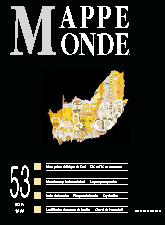
Maps and identity. Murals in South African cities (6 fig.)
The recurring theme of maps in urban murals invites us to investigate the process of the reconstruction of space and identity in the new South Africa. The maptaggers' choice of scale and spatial representation reflects a desire to reclaim an African identity and South Africa's will to regain its status among the nations.
keywords: CARTOGRAPHY, IDENTITY, MURALS, PICTURAL REPRESENTATION
Sandrine Assalin. Migration patterns: the diffusion of family names from southwestern France. (4 fig.)
The itineraries followed by migrants during the rural exodus can be shown up by the diffusion of surnames and analysed using a gravity model. While the greatest share of migration is towards the closest large towns, some migration is determined by a different spatial logic, which is detected through model residuals.
keywords: DIFFUSION, GRAVITY MODEL, MIGRATION, SURNAMES
The use of pastures in the Causse Méjan by Przewalski's horses. (6 fig.)
The Causse Méjean, long a sheep-grazing area, also attracts Przewalski's horses. Our aim in this paper is to verify, quantify and understand the spatial organisation of these animals. Our research theme, centred on the implementation of an application developed on the basis of the Arc/Info® programming language, seeks to retrace their movements and to obtain an overall characterisation of the levels of frequentation of the different vegetation facies present in the area.
keywords: ARC/INFO, CAUSSE MEJEAN, LIVESTOCK, SPATIAL ORGANISATION, VEGETATION FACIES
Lucian Dobraca. Management of critical areas: the Danube Delta between isolation and reserve. (4 fig.)
The establishment of a biosphere reserve in the Danube Delta has complicated the fragile relationship between man and the environment. The delta area, structured by activities linked to water, was disrupted by development that had little regard for the environment (1960-1989). The introduction of environmental management in 1991 (scientific objectives, sustainable economic development, monitoring and conservation) has limited the environmental damage, but multiplied the constraints on human life.
keywords: DANUBE DELTA, ENVIRONMENT, GEOGRAPHICAL ISOLATION, RESTRICTIVE SPACE
The spatial diffusion of geographical information technologies in France. (5 fig.)
The diffusion of geographical information technologies in France is in keeping with the conventional core-periphery model of the diffusion of technological innovations. Yet, beyond these broad national dynamics, the spatial distribution of GIT reflects institutional, cultural and spatial characteristics specific to the rapidly expanding sector of geomatics.
keywords: GEOGRAPHICAL INFORMATION, GEOMATIC, GIS, SPATIAL DIFFUSION, TECHNOLOGICAL INNOVATION
Changes in the Brazilian agropastoral space between 1975 and 1996. (5 fig.)
Brazilian agropastoral organisation has undergone significant change in the past decade. Land given over to crops and natural pastures has been reduced, whereas artificial pasture areas have increased. One million farms have disappeared. These changes may have been the result of the government's new economic program, which has affected agropastoral space utilisation.
keywords: AGRICULTURE, BRAZIL, LAND USE
Marcelo Sili. The Argentinian pampa: structure and evolution of a rural region. (4 fig.)
Modelling of historical stages through choremes produces an overview of the territorial social evolution of the Argentinian pampa, on which a prospective scenario for this region is constructed. These models can thus be used for analysis and prospection to support long-term territorial policy and decision-making.
keywords: ARGENTINA, CHOREME, PAMPA, RURAL DETAILED SURVEY, SPATIAL DYNAMICS
Jean-Christophe Foltête. Distance as a major determinant on land use and society in Doubs (France). (6 fig.)
This paper seeks to establish a relationship between forms of land use and social structures in the département of Doubs in eastern France. First, we construct a municipal land-use typology based on Corine Land Cover. Then we use a discriminant analysis to predict the type of land use in each municipality (commune), on the basis of social data alone. We interpret the discriminant functions with their social and spatial characteristics. This experiment shows a strong correlation between the two distributions, linked primarily to distance from urban centres and altitude.
keywords: CORINE LAND COVER, DISCRIMINANT ANALYSIS, DOUBS (FRANCE), LAND USE, PRODUCTION OF SPACE, SOCIAL STRUCTURE
Book reviews.
Mappemonde 4/98![]()
![]() Mappemonde 2/99
Mappemonde 2/99
For subscribe or buy this issue: BELIN
Last modified: May 10, 1999